As I have mentioned previously on the Penalty Loop Podcast (, S, G), I generally have lower expectations of any kind of athlete in their second season, especially when they had a strong rookie season. Despite some exceptions, when an athlete transitions from their rookie to their second season, things change.
In the first season everything is exciting and new, and there isn’t too much expectation. And even if there is, being a rookie is an acceptable excuse if things don’t work out right away. After season one, the realization starts to kick in that this – in the end- is a job now, that comes with higher expectations from fans, federations and “investors”. It takes many athletes the bigger part of a season to adjust; usually, at the expense of some performance.
This analysis is about a biathlete who, some say, had a disappointing season in her second year on the IBU World Cup.
Who is Vanessa Voigt?
When Vanessa fully joined the German World Cup team for the 2021/22 season, expectations were high as she had just won the IBU Cup (second highest level in biathlon) in the 2020/21 season. Already a very strong shooter and occasionally showing signs of fast skiing potential, I was really looking forward to see how she would do at the next level. Arriving in a team with a mix of strong but older veterans and younger athletes who still had something to prove, she has the potential to grow into a core athlete for years to come. She is fun to watch too, with a serious demeanour yet a fun spark in her eyes. Oh, and she also happens to be the twin sister of one of the best photographers in biathlon (and other sports).
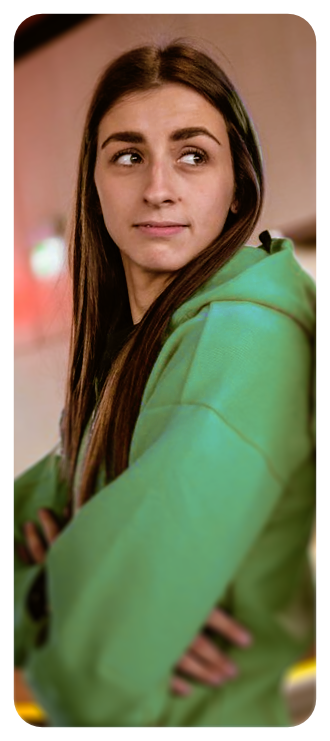
Let’s start with some basic numbers
After winning the IBU Cup and a solid 13th place in her first full season on the World Cup, many expected her to do better and possibly challenge for the Overall title. From that perspective a 12th place at the end of her second season was disappointing. Much was said about her shooting percentage, as she did not always look comfortable in the range. Many assumed her 1% drop compared to last year was a result of her faster shooting. She even eluded to that herself at some point. But what does the data tell us? When we look at the average of her race ranks per season for a couple of variables (note that Final Rank is not an average) we get a general idea of how the seasons compare.
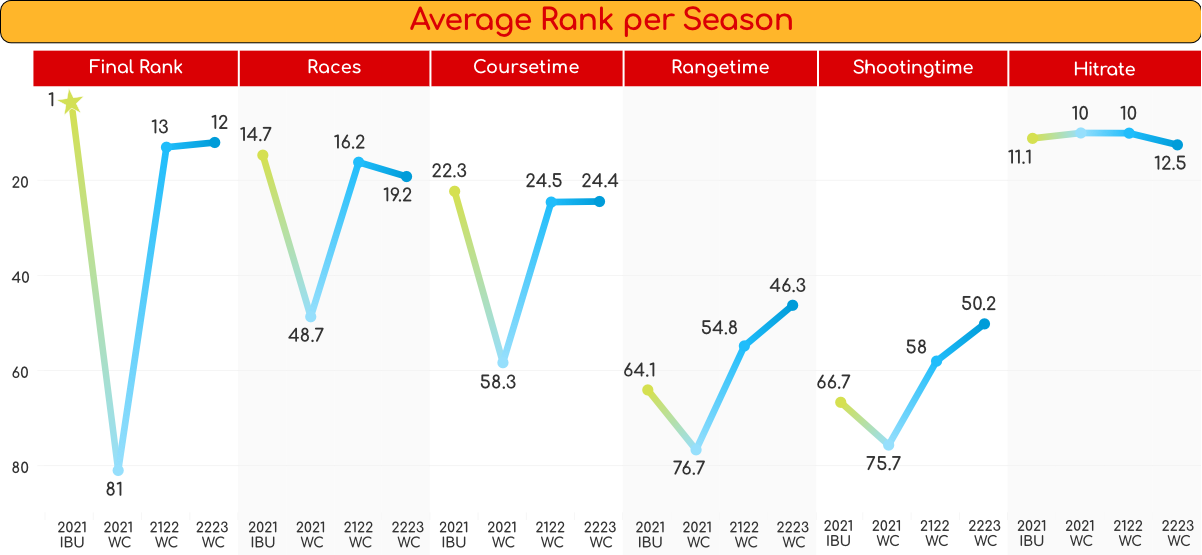
Although she ended pretty much in the same place in the final ranking, her average race rank did drop by 3 places. Her course-time stayed the same and she improved her range- and shooting-time ranks. In her strongest quality she dropped more than 2 places. Are these the numbers that made people say/think her season was worse?
Diving into the details
With so many variables in biathlon, it is better to work with subsets that have more similarities. As athletes have to lay down on the shooting for Prone shooting, the times per shooting vary significantly from the Standing shooting position. Below, the charts for shooting percentages and shooting-times are therefore separated for Prone and Standing.
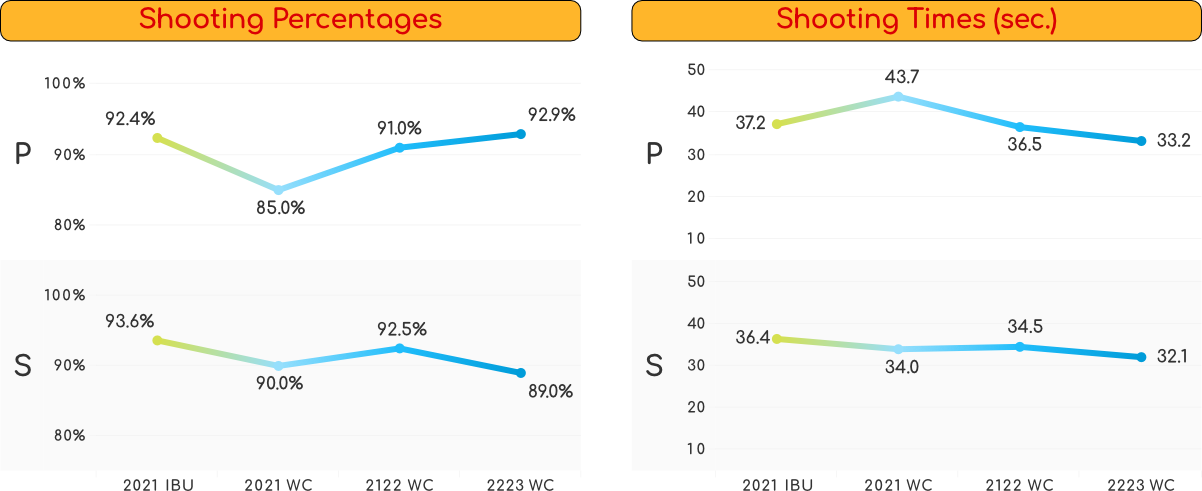
The charts show that her development in shooting percentages and times was different between Prone and Standing; her Prone shooting got better and faster on average, but her Standing shooting dropped, while also getting faster. I just want to mention that although we’re stating “worse” and “dropped”, her shooting percentages compared to the field are quite exceptional!
Diving a little deeper
As most of you will know, the IBU World Cup has four disciplines for individual races: the sprint, pursuit, individual and mass start. The sprint races have only two shootings of 5 shots, one Prone and one Standing. The other three disciplines have four shootings of five shots. As we typically also see differences in shooting times between two- and four shooting races, the charts below are split up further to reflect this.
And although the ranks and raw numbers shown above give a good indication, comparing her shooting times to that of the field average gives us a better idea of how she performed in the race. After all, if she shoots a second slower, but the rest of the field takes three more seconds, she is actually improving her performance. This Vanessa -vs- the field average ratio is calculated for each race, and then averaged per season.
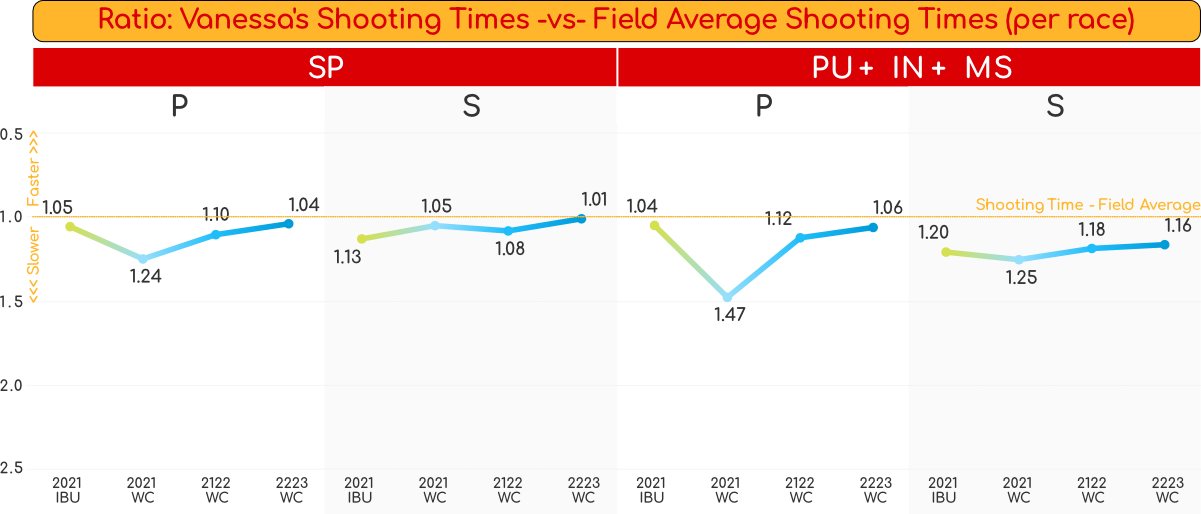
We can clearly see that despite shooting slower than the field average for both Prone and Standing in two- and four shooting races, she improved her performance compared to last season and is getting closer to the field average.
So does her faster shooting impact her hit rate?
Shooting faster in itself is great, but if it has a negative impact on shooting percentages it may not be worth it in the big picture (and we’re also ignoring the skiing in this analysis). So when we take the “Vanessa -vs- the field average”-ratio from the chart above and keep it on the same vertical axis, but plot her shooting percentages on the horizontal axis, we can look at that relationship and find if she is actually trending in the right direction. In this case, towards the top right corner; top = faster shooting and right = better percentage.
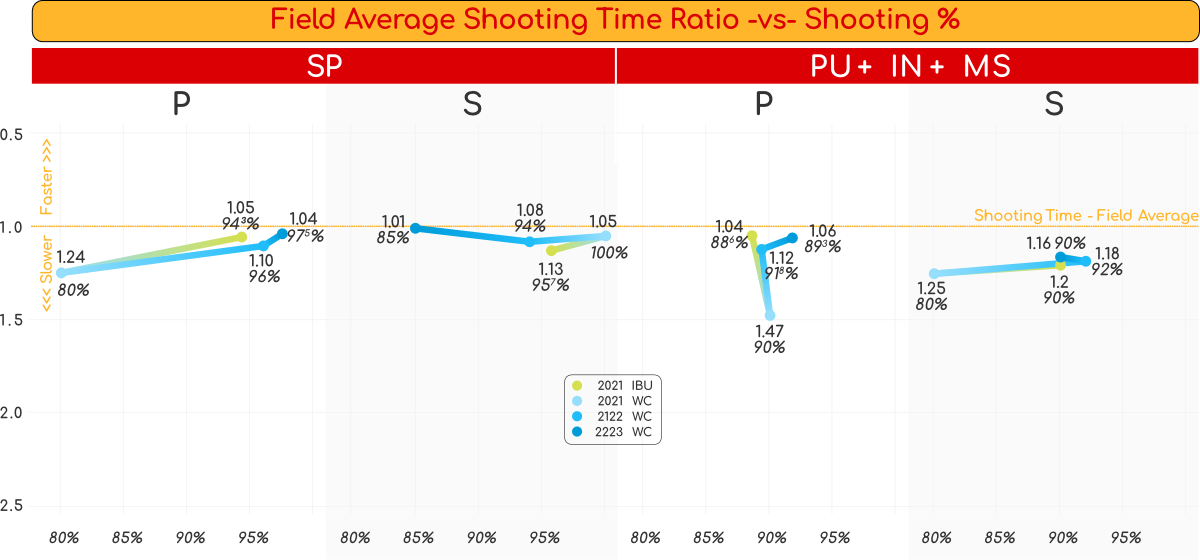
The data shows that for all disciplines her Prone shooting is faster and better than last season, relative to the field average. However, the Standing shooting percentages have dropped compared to the rookie season, possible due to her faster shooting.
How far is she away from the fastest shooters?
Like we compared Vanessa’s shooting times with the field average shooting times in the previous charts, we can also compare her times to the fastest shooter per race and average that per season. Knowing her shooting speed is something she can still improve, is she at least getting closer to the top?
The final chart in this analysis shows the “Vanessa -vs- the fastest shooters”-ratio on the vertical axis, and her shooting percentages on the horizontal axis. Again, the goal is to trend right and towards the top.

Not surprisingly we can see a move towards the top of the chart for all four sections, but as we saw before, her shooting percentages for the Standing position are going in the wrong direction.
So? Sophomore Jinx?
Comparing last season, her second full season in the World Cup with her rookie year, I think she handled the transition quite well. And knowing her shooting speed was below average it only made sense that she tried to improve on it. Being a naturally strong shooter she must have felt awkward and frustrated when her Standing shooting percentages were taking a hit. But as she improved her speed in Prone shooting while having even better percentages, I have no doubt she will be able to do that for Standing shooting as well in the next season. If she can combine that with skiing faster (as she has already demonstrated her ability to do so occasionally) more consistently, she can be an outsider for a crystal globe, even the overal title. For Vanessa Voigt there is no looking back, only forward to great things to come!

Note regarding the data from the IBU biathlonresults page: based on analysis of shooting time ranges and occurrences for all athletes in the data source, and knowing the IBU data occasionally contains no or incorrect data, shooting times under 20 seconds and above 60 seconds, as well as null (no value at all) has been removed from the data source. DNF, DNS, DSQ, LAP and results with Null values have also been removed from the data source.
